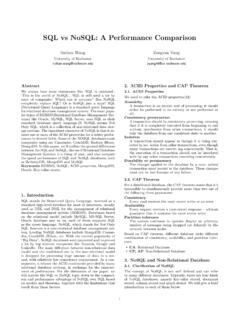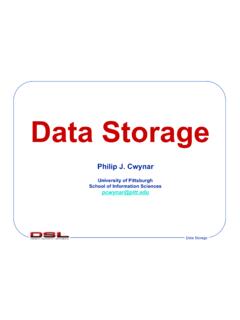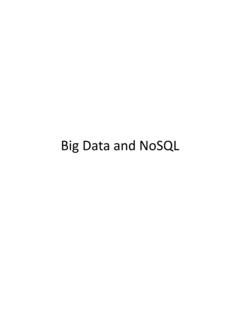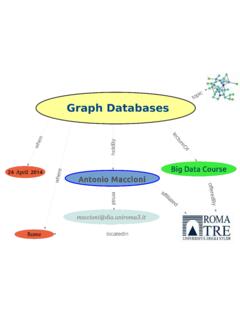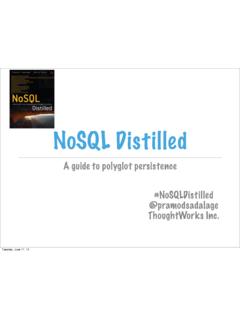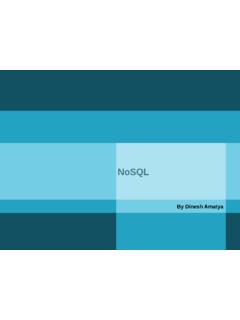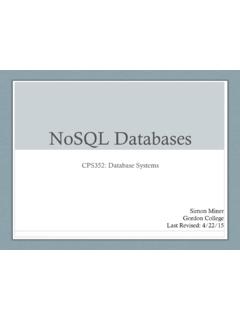Transcription of SQL vs NoSQL: A Performance Comparison
1 SQL vs nosql : A Performance ComparisonRuihan WangUniversity of YangUniversity of always hear some statements like SQL is outdated , This is the world of nosql , SQL is still used a lot bymost of companies. Which one is accurate? Has NoSQLcompletely replace SQL? Or is nosql just a hype? SQL(Structured Query Language) is a standard query languagefor relational database management system. The most popu-lar types of RDBMS(Relational Database Management Sys-tems) like Oracle, MySQL, SQL Server, uses SQL as theirstandard database query language.
2 [3] nosql means NotOnly SQL, which is a collection of non-relational data stor-age systems. The important character of nosql is that it re-laxes one or more of the ACID properties for a better perfor-mance in desired fields. Some of the nosql databases mostcompanies using are Cassandra, CouchDB, Hadoop Hbase,MongoDB. In this paper, we ll outline the general differencesbetween the SQL and nosql , discuss if Relational DatabaseManagement Systems is a thing of past, and also comparethe speed Performance of SQL and nosql databases, suchas BerkeleyDB, MongoDB and :RDBMS, nosql , ACID properties, MongoDB,Oracle, Key-value stores,1.
3 IntroductionSQL stands for Structured Query Language, invented as astandard high-level interface for most of databases, usuallyused as DDL and DML for the management of relationaldatabase management system (RDBMS). Databases basedon the relational model include MySQL, MS-SQL Server,Oracle database and so on, each of them supports SQLas the query language. nosql , which stands for Not OnlySQL, however is a non-relational database management sys-tem. Leading nosql databases include MongoDB, Cassan-dra, CouchDB, HBase, etc. With the current popularity of Big Data , nosql databases were pioneered and improveda lot by top internet companies like Amazon, Google andLinkedIn.
4 The main difference between non-relational datamodel and the traditional one is, the non-relational modelis designed for processing huge amount of data in a sec-ond, with relatively low consistency requirement. As a con-sequence, it relaxes the ACID constraints provided by manyrelational database systems, in exchange for the improve-ment of Performance . For the discussion of our paper, wewill narrow the SQL vs nosql topic down to the compari-son and Performance advantage of nosql over SQL basedon models and theorems, together with the limitations thatresult from those ACID Properties and CAP ACID PropertiesWe need to refer the ACID properties[12]:AtomicityA transaction is an atomic unit of processing.
5 It shouldeither be performed in its entirety or not performed preservationA transaction should be consistency preserving, meaningthat if it is completely executed from beginning to endwithout interference from other transactions, it shouldtake the database from one consistent state to transaction should appear as though it is being exe-cuted in iso- lation from other transactions, even thoughmany transactions are execut- ing concurrently. That is,the execution of a transaction should not be interferedwith by any other transactions executing or permanencyThe changes applied to the database by a com- mittedtransaction must persist in the database.
6 These changesmust not be lost because of any CAP TheoremFor a distributed database, the CAP theorem states that it simpossible to simultaneously provide more than two out ofthe following three guarantees:ConsistencyEvery read receives the most recent write or an errorAvailabilityEvery request receives a (non-error) response withoutguarantee that it contains the most recent writePartition toleranceThe system continues to operate despite an arbitrarynumber of messages being dropped (or delayed) by thenetwork between nodesBased on CAP theorem, different database picks differentcombination of consistency, avalability, and partition toler-ence: CA: Relational Database CP, AP: Non-Relational Database3.
7 nosql and Non-Relational Clarification of NoSQLThe concept of nosql is not well defined and can referto many different databases. Typically, there are four kindsof nosql databases, namely key-value stored, documentstored, column stored and graph stored. We will give a briefintroduction to each of them versus NoSQLKeyValue/test/10 Hello World (a) key-value store{_id : 10floatVal : : 'Hello World'}(b) Document storeColumnsValueid10; .. ; ..stringVal Hello World ; ..(c) Column storeid:10 Type:Int(d) Graph storeFigure in different nosql Key-value StoredKey-value database is the easiest one to understand amongthose four.
8 The database manage system simply stores datain an unstructured dictionary (or hash table). The keyin each records is the same as the primary key in SQLdatabases, while the value is an array of data. Typical key-value databases are BerkeleyDB, LevelDB and Document StoredThe main idea of document-oriented database is the notionof document. Although each database implementation dif-fers on the definition of this, they are all assume the dataare encapsulated in some standard formating. One of themost popular document-oriented database, MongoDB, usesthe JSON format as its storage; while other databases likeBaseX or YAMLDB use XML and YAML as their Column StoredA column-oriented database store tables by columns, in-stead of by rows.
9 This difference is mainly handled byFigure time (less is better)the database manage systems, meaning a column-orienteddatabase is generally compatible with traditional row-baseddatabase; both of them can use SQL to load data and per-form query. Some example of column-oriented databases areSAP HANA, Amazon Redshift and Sybase Graph storedA graph database is a database that store data with nodes,edges and properties. Nodes represent entities like peopleor companies, while edges and properties represent relation-ships between entities. With the notion of graphs, we canmodel data naturally and store them in logic level.
10 Examplesof graph databases are AllegroGraph and ConfigurationTo evaluate the Performance of relational databases andnon-relational databases, we are using a benchmark toolfrom stssoft[11] to test the read and write speeds amongrelational database (MySQL), key-value storage (BerkeleyDB), and document storage (MongoDB). The test platformconfiguration is: OS: Microsoft Windows 10 Pro 64 bit CPU: Intel (R) Core (TM) i5-3210M CPU @ RAM: DDR3 8GB 1333 MHz Storage: SAMSUNG MZ7PC128 HAFU-000H1 Database Settings: InsertsPerQuery: 5000; Indexing Tech-nology: BTree.
